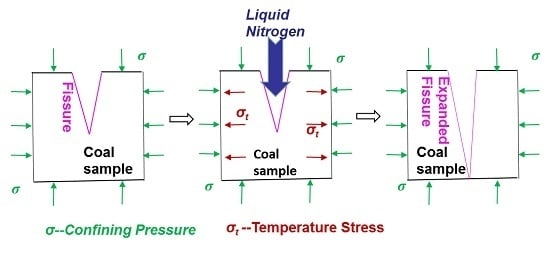Mechanism of Structural Damage in Low Permeability Coal Material of Coalbed Methane Reservoir under Cyclic Cold Loading
Abstract
1. Introduction
2. Materials and Methods
2.1. Preparation of Coal Samples
2.2. Experimental Method
3. Results and Discussion
3.1. Experimental Results
3.1.1. Surface Fracture Morphology
3.1.2. Determination of Damage Degree of Overall Structure of Coal Sample
3.1.3. Uniaxial Compressive Strength of Coal Sample after Cyclic Cold Loading
3.2. Theoretical Analysis
3.2.1. Influence of Temperature Stress on Structural Damage of Coal Sample
3.2.2. The Influence of Confining Pressure on Structural Damage of Coal Sample
3.2.3. Numerical Model
4. Conclusions
Author Contributions
Funding
Acknowledgments
Conflicts of Interest
References
- Mark, Z.J.; Mark, A.; Delucchi, M.A.; Cameron, S.J.; Coughlin, C.A.; Hay, I.P.; Manogaran, Y.; Shu, A.K.K. Impacts of Green New Deal Energy Plans on Grid Stability, Costs, Jobs, Health, and Climate in 143 Countrie. One Earth 2019, 1, 449–463. [Google Scholar]
- Saptorshee, K.C.; Massimiliano, M. Energy intensity and green energy innovation: Checking heterogeneous country effects in the OECD. Struct. Chang. Econ. Dyn. 2020, 52, 328–343. [Google Scholar]
- Ishaq, H.; Dincer, I. A comparative evaluation of OTEC, solar and wind energy based systems for clean hydrogen production. J. Clean. Prod. 2019, 11, 8736. [Google Scholar] [CrossRef]
- Wagner, A.O.; Lackner, N.; Mutschlechner, M.; Prem, E.M.; Markt, R.; Illmer, P. Biological Pretreatment Strategies for Second-Generation Lignocellulosic Resources to Enhance Biogas Production. Energies 2018, 11, 1797. [Google Scholar] [CrossRef] [PubMed]
- Wayne, N. Clean, Safe Nuclear Power? Drillers Have a Role. Natl. Driller 2019, 40, 6. [Google Scholar]
- Siddiqui, O.; Dincer, I.; Yilbas, B.S. Development of a novel renewable energy system integrated with biomass gasification combined cycle for cleaner production purposes. J. Clean. Prod. 2019, 241, 18345. [Google Scholar] [CrossRef]
- Ajay, K.; Singh, J.K. Fugitive Methane Emissions from Indian Coal Mining and Handling Activities: Estimates, Mitigation and Opportunities for its Utilization to Generate Clean Energy. Energy Procedia 2016, 90, 336–348. [Google Scholar]
- Hu, Q.T.; Liang, Y.P.; Wang, H.; Zou, Q.L.; Sun, H.T. Intelligent and integrated techniques for coalbed methane (CBM) recovery and reduction of greenhouse gas emission. Environ. Sci. Pollut. Res. Int. 2017, 24, 17651–17668. [Google Scholar]
- Tutak, M.; Brodny, J. Forecasting Methane Emissions from Hard Coal Mines Including the Methane Drainage Process. Energies 2019, 12, 3840. [Google Scholar] [CrossRef]
- Moore, T.A. Coalbed methane: A review. Int. J. Coal Geol. 2012, 101, 36–81. [Google Scholar] [CrossRef]
- Cao, D.L. Monte-Carlo simulation of seepage in fractured rock mass. J. CRSRI 1989, 3, 55–61. [Google Scholar]
- Zhang, Z.Q.; Zhao, H.C.; Zhang, X.L. Study on AR Technology of Low Permeability Coal-bed Methane Reservoirs by Freezing and Thawing Cycles. Coal Technol. 2015, 34, 144–146. [Google Scholar]
- Maxim, C.; Andrey, C. Evaluating characteristics of high-rate hydraulic fractures driven by wellbore energy source. Eng. Fract. Mech. 2019, 10, 6702. [Google Scholar]
- Robin, L.; Franck, V.; Nicolas, A.; Hervé, L.P.; Jean, L.P.; Li, H.; Paul, T.; Marie-Luce, C.; Stephane, G.; Gweltaz, M.; et al. Reply to Comment on “Large-scale geometry, offset and kinematic evolution of the Karakorum fault, Tibet”. Earth Planet. Sci. Lett. 2004, 1, 159–163. [Google Scholar]
- Chen, S.L.; Huang, B.X.; Xu, J. Experimental Study of Basic Law of High Pressure Water Jet Punching. Coal Min. Technol. 2017, 4, 38. [Google Scholar]
- Lin, B.Q.; Shen, C.M. Coal permeability-improving mechanism of multilevel slotting by water jet and application in coal mine gas extraction. Environ. Earth Sci. 2015, 10, 5975–5986. [Google Scholar] [CrossRef]
- Li, H.L. The Composite Perforating Dynamic Testing Technology Research of Coal-bed Gas Well. Master’s Thesis, North University of China, Taiyuan, China, 2013. [Google Scholar]
- Yuan, W.; Liu, S.; Wang, W.; Su, X.; Li, Z.; Li, J.; Wen, L.; Chang, J.; Sun, X. Numerical study on the fracturing mechanism of shock wave interactions between two adjacent blast holes in deep rock blasting. Earthq. Eng. Eng. Vib. 2019, 18, 735–746. [Google Scholar] [CrossRef]
- Tran, D.; Settari, A.; Nghiem, L. Initiation and Propagation of Secondary Cracks in Thermo-Poro elastic Media. In Proceedings of the 46th US Rock Mechanics/Geomechanics Symposium, Chicago, IL, USA, 24–27 June 2012. [Google Scholar]
- Li, J.Z. The enlightenment on the construction of urban infrastructure in China from Dujiangyan Irrigation Project. In Proceedings of the Abstracts of International Conference on Civil, Architectural, Structural and Constructional Engineering, Busan, Korean, 15–17 July 2016. [Google Scholar]
- Ren, S.R.; Fan, Z.K.; Zhang, L.; Yang, Y.; Luo, J.; Che, H. Mechanisms and experimental study of thermal-shock effect on coal-rock using liquid nitrogen. J. Rock Mech. Eng. 2013, S2, 3790–3794. [Google Scholar]
- Cai, C.-Z.; Li, G.-S.; Huang, Z.-W.; Shen, Z.-H.; Wang, H.-Z.; Tian, S.-C.; Wei, J.-W. Experiment study of rock porous structure damage under cryogenic nitrogen freezing. Rock Soil Mech. 2014, 4, 965–971. [Google Scholar]
- Zhang, C.H.; Zhao, Q.S.; Wang, L.G.; Zhao, Q.S.; Li, W.L. Permeability evolution model and numerical analysis of coupled coal deformation, failure and liquid nitrogen cooling. J. Hebei Univ. Sci. Technol. 2015, 36, 90–99. [Google Scholar]
- Grundmann, S.R.; Rodvelt, G.D.; Dials, G.A.; Allen, R.E. Cryogdnics nitrogen as a hydraulic fracture fluid in the devonian shale. In Proceedings of the SPE Eastern Regional Conference, Pittsburgh, PA, USA, 9–11 November 1998. [Google Scholar]
- Coetzee, S.S.; Neomagus, H.W.J.P.; Bunt, J.R.; Strydom, C.A.; Schobert, H.H. The transient swelling behavior of large (−20+16mm) South African coal particles during low-temperature devolatilisation. Fuel 2014, 136, 79–88. [Google Scholar] [CrossRef]
- Li, H.W.; Wang, L.G.; Zhang, C.H.; Zhang, H.; Zhou, H.; Geng, Y.Y. Investigation on damage laws of loading coal samples under cyclic cooling treatment. J. China Coal Soc. 2017, 9, 2345–2352. [Google Scholar]
- Li, H.W.; Wang, L.G.; Niu, F.M.; Liu, W.F.; Zhang, C.H. Study on effect of freeze-thaw cycle with liquid nitrogen on crack extension of coal at different initial temperatures. China Saf. Sci. J. 2015, 10, 121–126. [Google Scholar]
- Zhang, C.H.; Guo, X.K.; Li, H.W.; Zhao, N.; Wang, L.G. Study on influence of liquid nitrogen infiltration to saturated water coal fracture expanded. Coal Sci. Technol. 2016, 6, 99–105. [Google Scholar]
- Cai, C.Z.; Li, G.S.; Huang, Z.W. Experiment of coal damage due to super-cooling with liquid nitrogen. J. Nat. Gas Sci. Eng. 2015, 22, 42–48. [Google Scholar] [CrossRef]
- Shi, G.; Shen, L.D. Evaluations of the lithological character and physical property of rocks from the relation between wave velocity and pressure-an experimental study. Chin. J. Geophys. 1990, 2, 212–218. [Google Scholar]
- Makhutov, N.A.; Matvienko, Y.G. Griffith theory and development of fracture mechanics criteria. Mater. Sci. 1993, 3, 115–123. [Google Scholar] [CrossRef]
- Finnie, I.; Cooper, G.; Berlie, J. Fracture propagation in rock by transient cooling. Int. J. Rock Mech. Min. Sci. Géoméch. Abstr. 1979, 16, 11–21. [Google Scholar] [CrossRef]
- Zhang, Y.P. Study on Liquid Nitrogen Fracturing Technology in Coalbed Methane Well. Ph.D. Thesis, Southwest Petroleum University, Chengdu, China, 2015. [Google Scholar]
- Li, H.W.; Wang, L.G.; Zhang, C.H.; Zhang, H.; Zhou, H.; Su, R.H. Structural damage mechanism for cold loaded coal samples under different confining pressures. Chin. J. Appl. Mech. 2017, 04, 788–794+823. [Google Scholar]
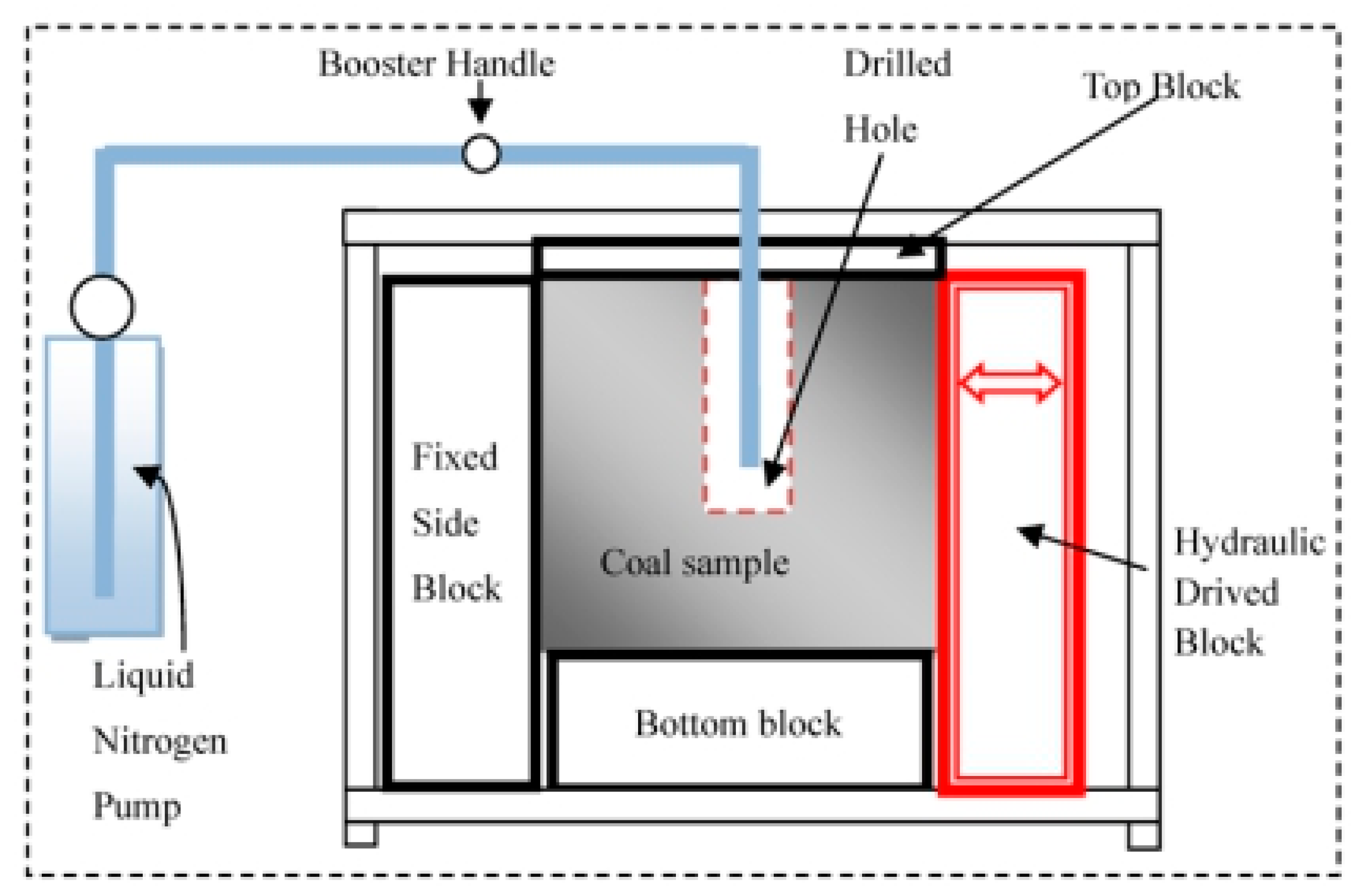

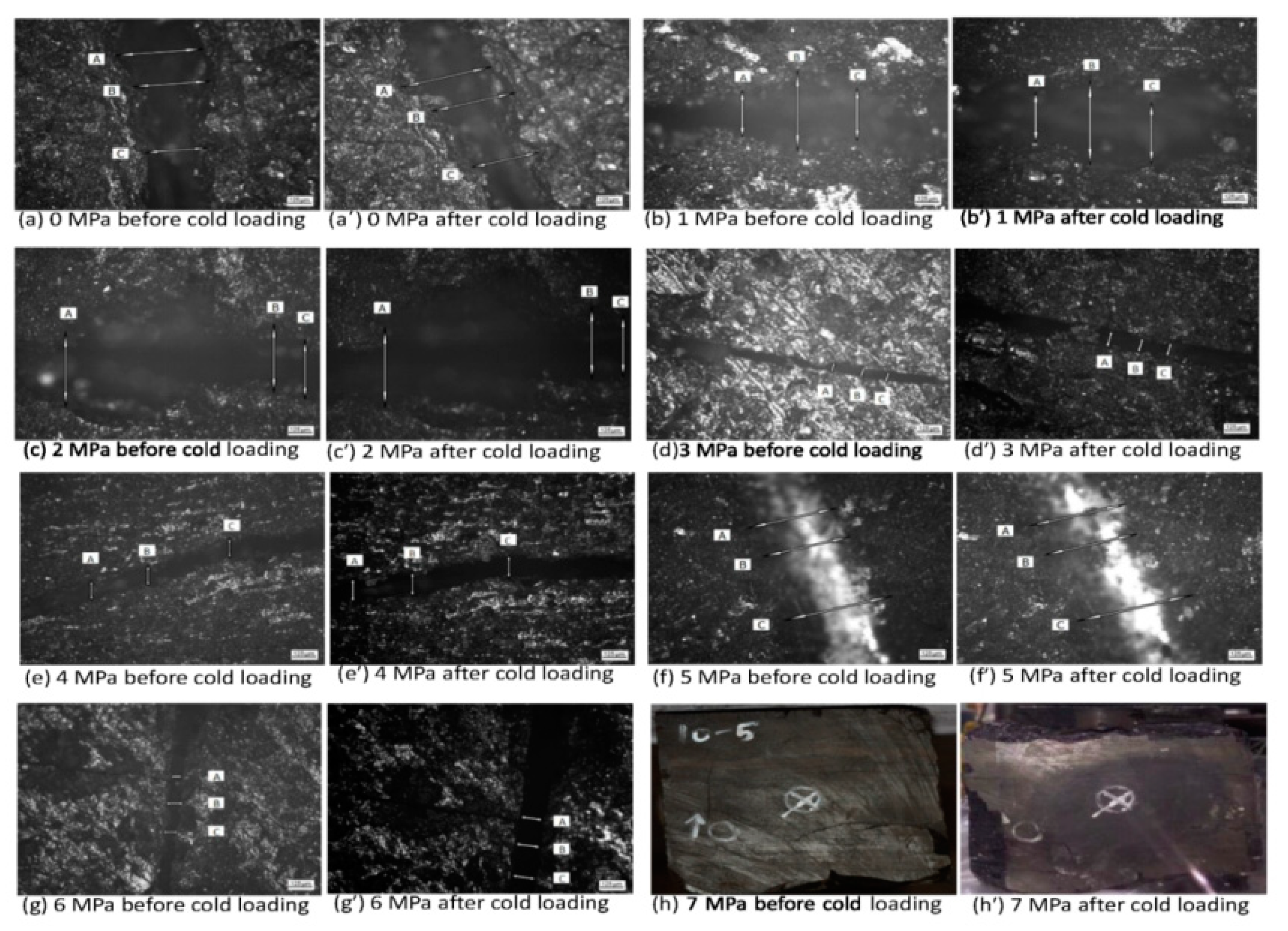
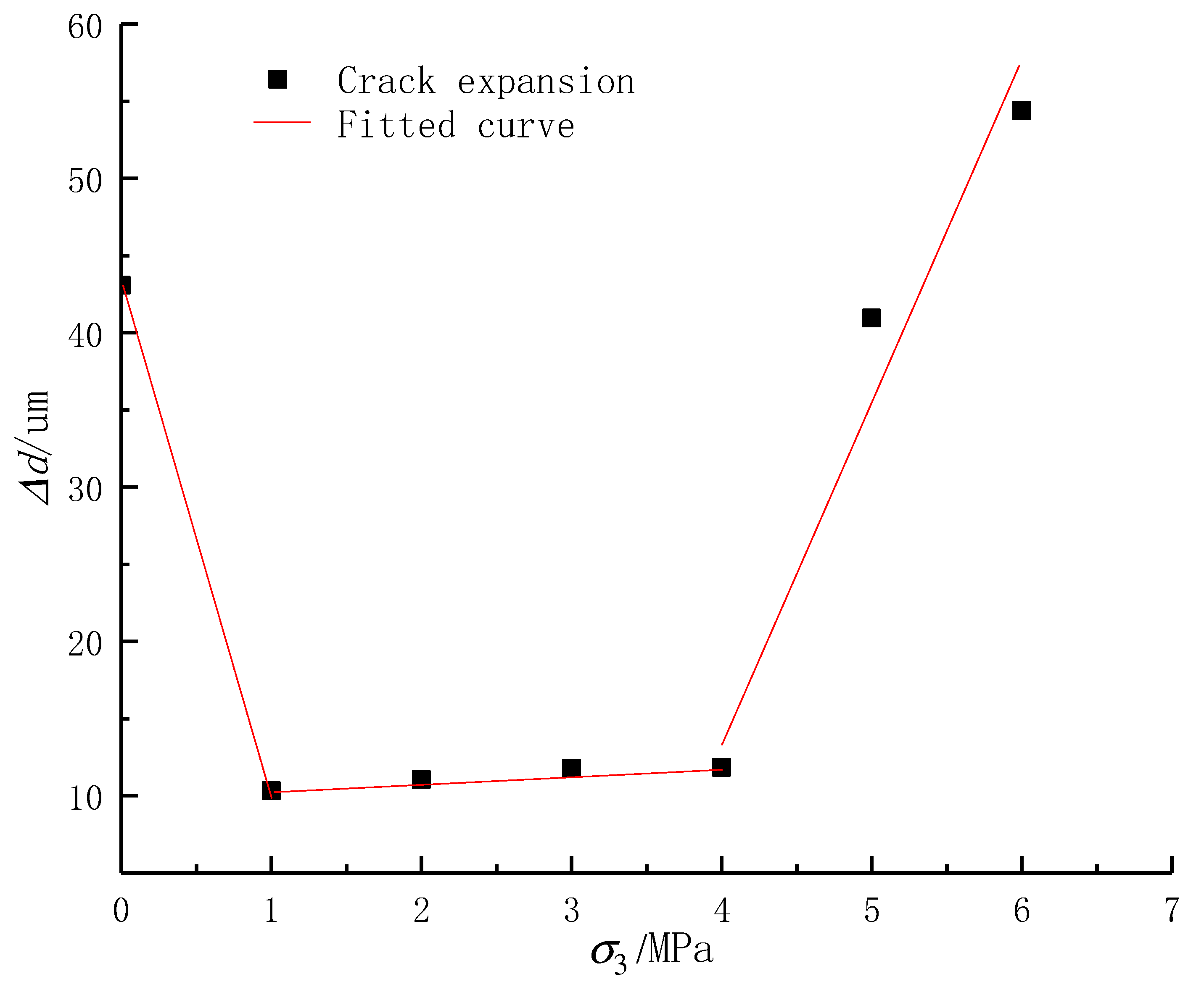
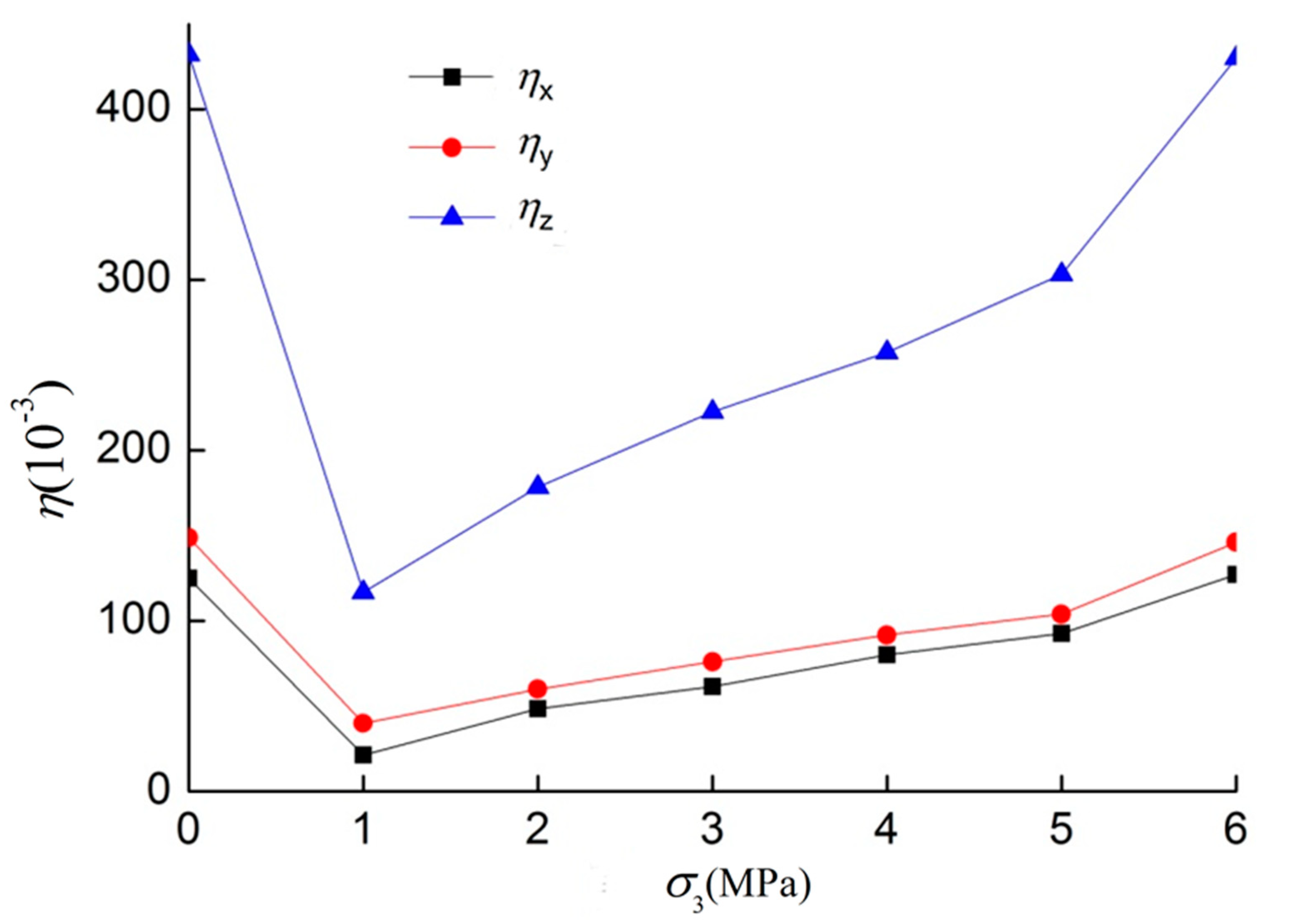
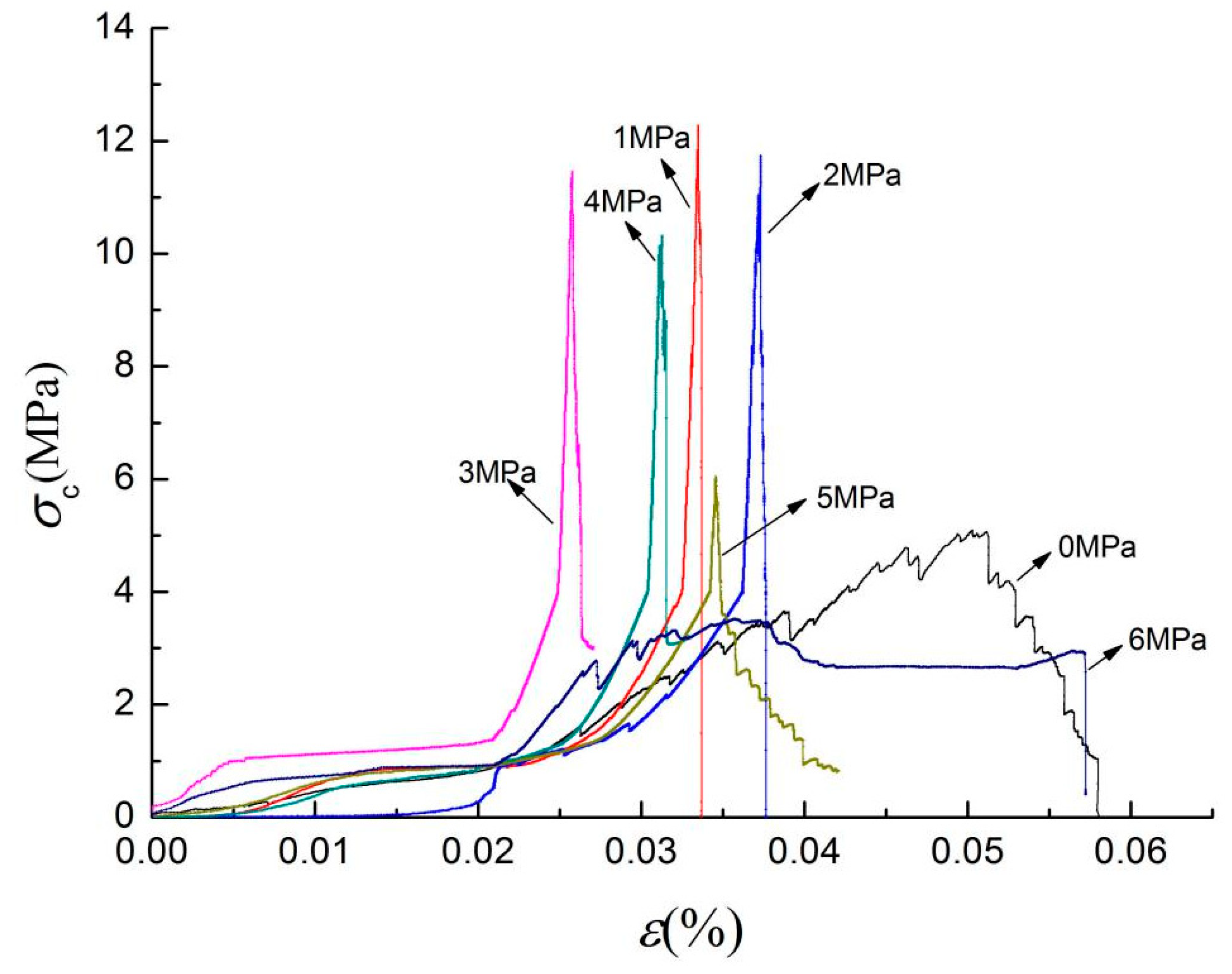

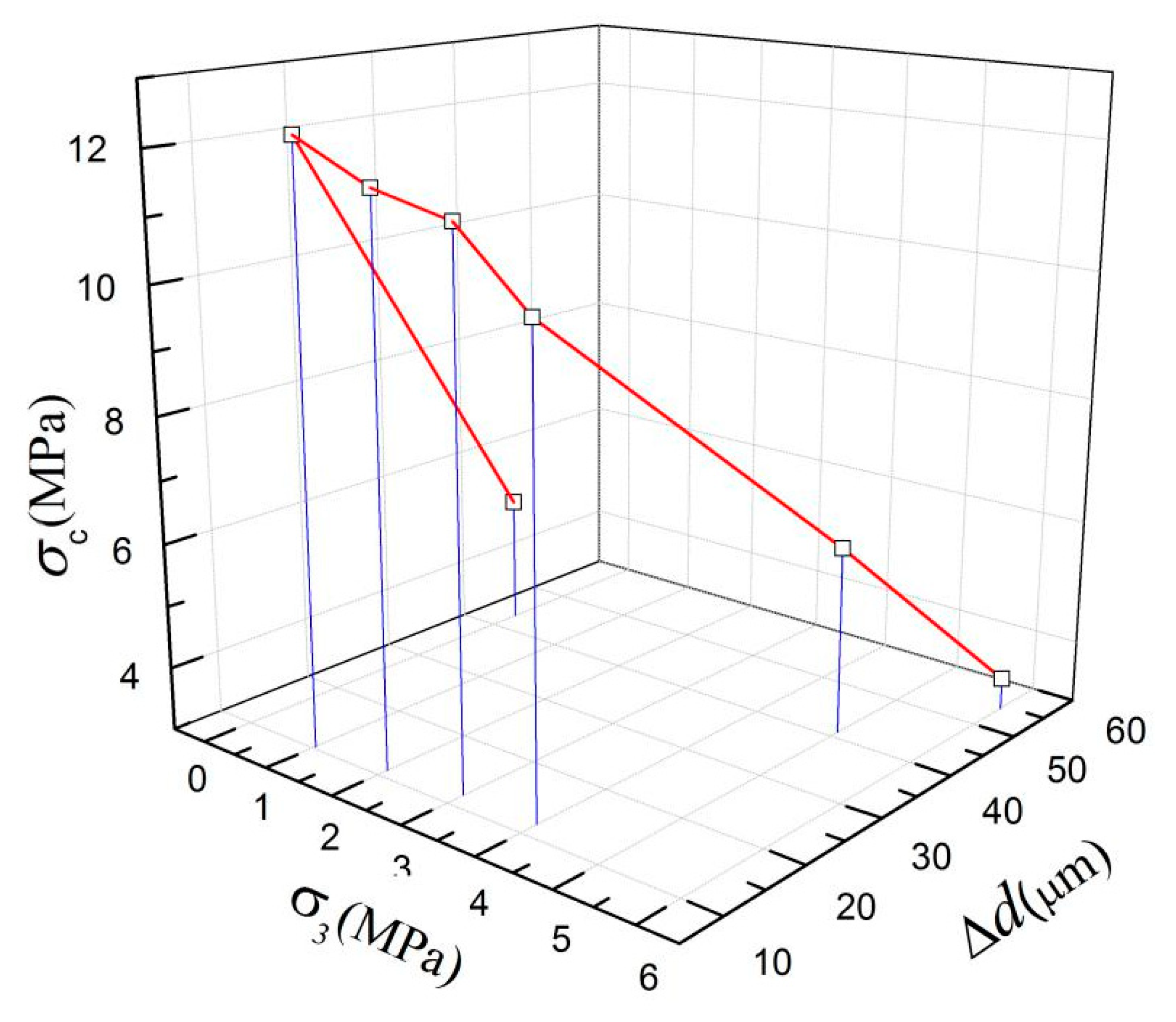
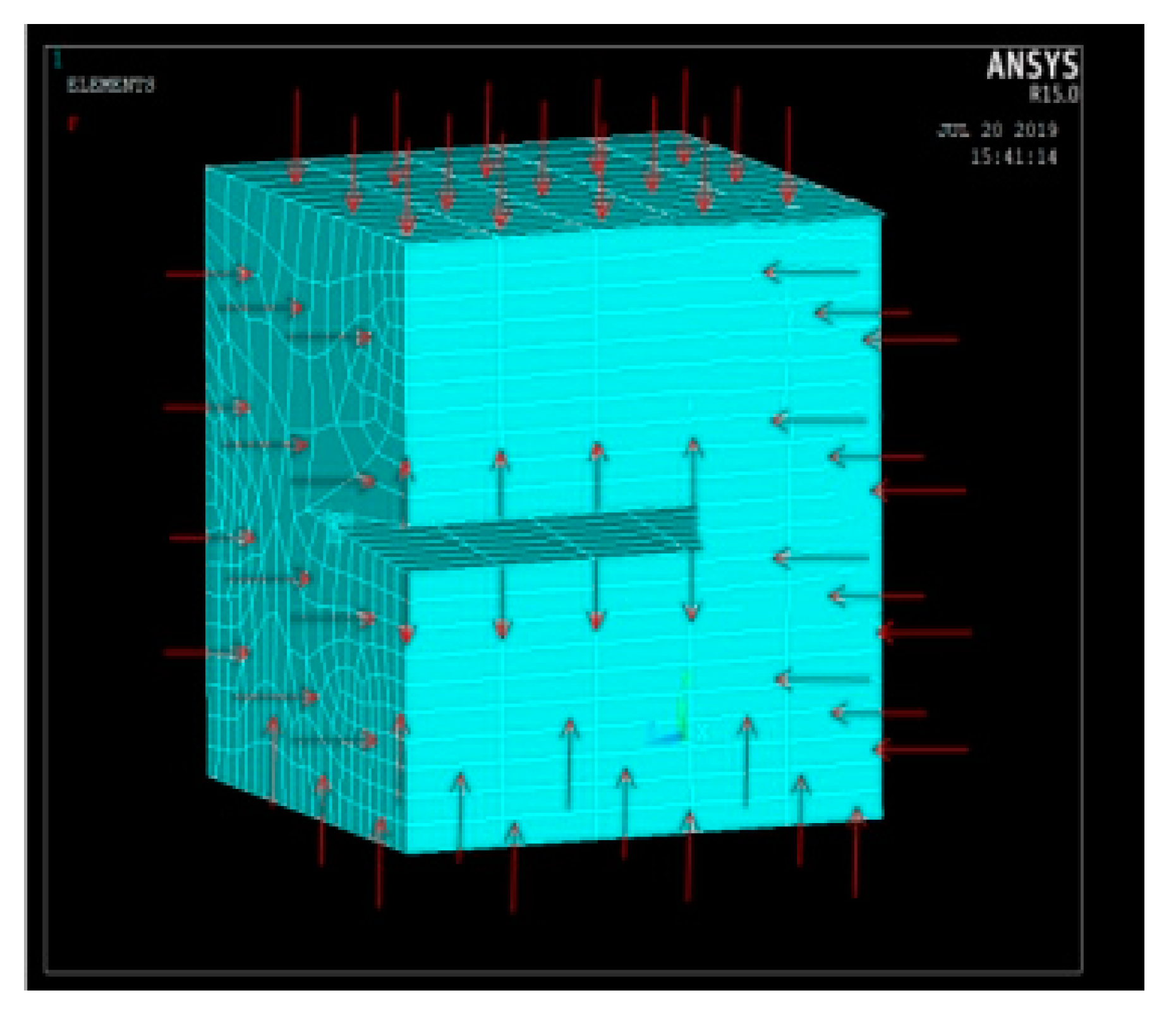
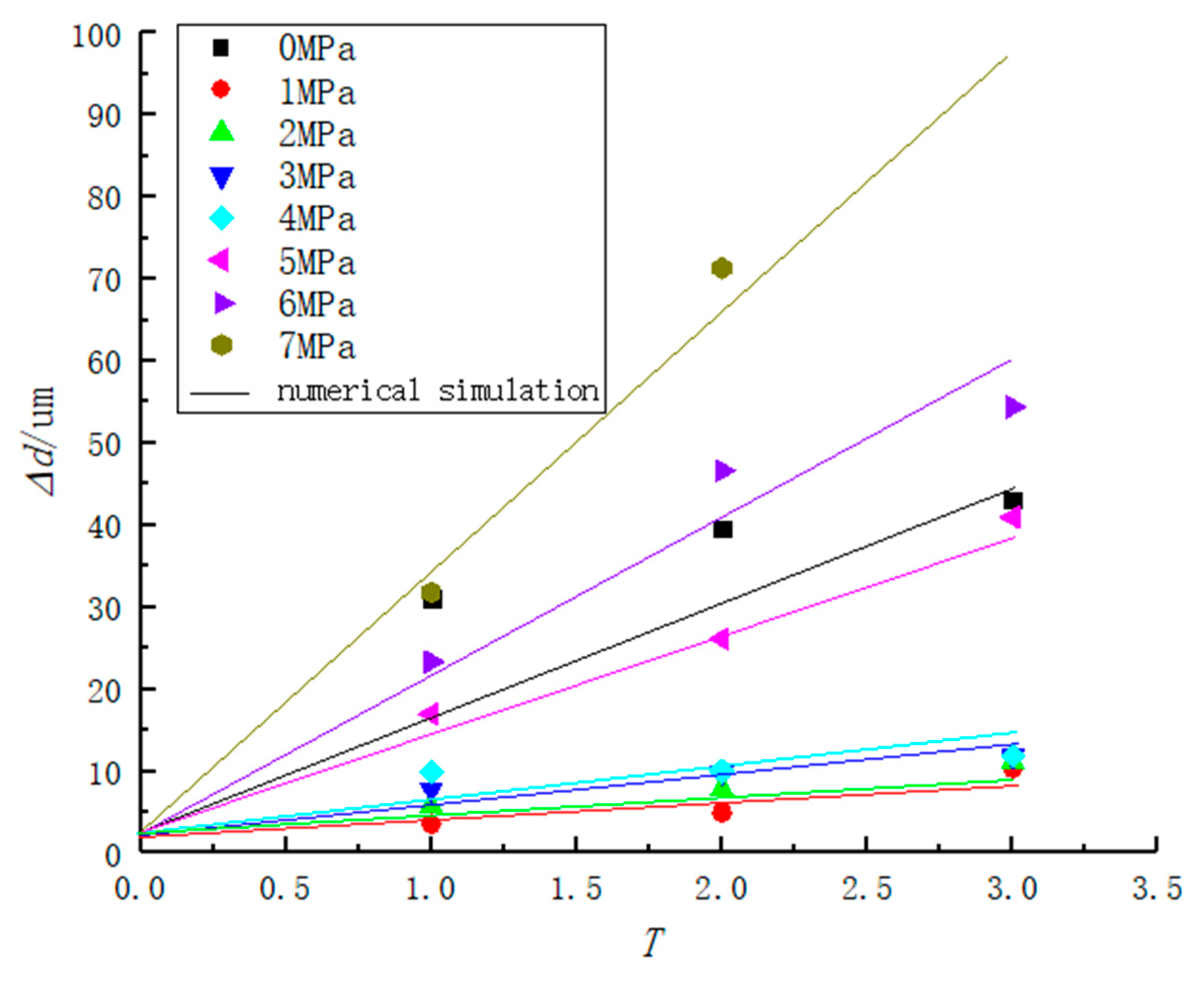
| Confining Pressure (MPa) | 0 | 1 | 2 | 3 | 4 | 5 | 6 | 7 |
|---|---|---|---|---|---|---|---|---|
| Coal sample number | 1-3 | 2-3 | 3-3 | 4-3 | 3# | 5-3 | 6-3 | 10# |
| Sample Number | d0/μm | dn/μm | Extension Δd/μm | ||||||
|---|---|---|---|---|---|---|---|---|---|
| A | B | C | Average | A | B | C | Average | ||
| 1-3 | 489.41 | 438.56 | 341.10 | 423.02 | 523.31 | 483.05 | 391.95 | 466.10 | 43.08 |
| 2-3 | 305.08 | 608.17 | 349.57 | 420.94 | 326.75 | 564.04 | 403.02 | 431.27 | 10.33 |
| 3-3 | 497.88 | 451.27 | 396.19 | 448.45 | 514.59 | 467.98 | 395.95 | 459.51 | 11.06 |
| 4-3 | 61.44 | 65.67 | 63.55 | 63.55 | 80.26 | 73.91 | 68.95 | 74.61 | 11.79 |
| 3# | 25.31 | 44.37 | 69.80 | 46.49 | 37.14 | 54.08 | 83.75 | 58.32 | 11.83 |
| 5-3 | 512.71 | 502.12 | 622.88 | 545.90 | 552.97 | 540.25 | 667.31 | 586.84 | 40.94 |
| 6-3 | 55.08 | 97.45 | 80.50 | 77.67 | 122.88 | 139.83 | 133.47 | 132.06 | 54.39 |
| 10# | broken | ||||||||
| Confining Pressure/MPa | a/µm × MPa−1 | b/µm |
|---|---|---|
| 0 ≤ σ3 ≤1 | −32.75 | 43.08 |
| 1 < σ3 <4 | 0.52 | 9.95 |
| 4 < σ3 <6 | 21.28 | −70.68 |
| Sample Number | Acoustic Wave Attenuation Rates | ||
|---|---|---|---|
| ηx × 10−3 | ηy × 10−3 | ηz × 10−3 | |
| 1-3 | 125.13 | 148.91 | 432.24 |
| 2-3 | 21.29 | 39.99 | 116.84 |
| 3-3 | 48.45 | 60.01 | 178.47 |
| 4-3 | 61.58 | 76.16 | 222.79 |
| 3# | 80.11 | 91.76 | 257.37 |
| 5-3 | 92.64 | 104.00 | 303.28 |
| 6-3 | 127.07 | 146.13 | 429.97 |
| 10# | — | — | — |
| Confining Pressure/MPa | a | b/MPa |
|---|---|---|
| 0 ≤ σ3 ≤ 1 | 7.2 | 5.1 |
| 1 < σ3 < 4 | −0.63 | 13.0 |
| 4 < σ3 < 6 | −3.4 | 23.6 |
© 2020 by the authors. Licensee MDPI, Basel, Switzerland. This article is an open access article distributed under the terms and conditions of the Creative Commons Attribution (CC BY) license (http://creativecommons.org/licenses/by/4.0/).
Share and Cite
Li, H.; Zuo, J.; Wang, L.; Li, P.; Xu, X. Mechanism of Structural Damage in Low Permeability Coal Material of Coalbed Methane Reservoir under Cyclic Cold Loading. Energies 2020, 13, 519. https://doi.org/10.3390/en13030519
Li H, Zuo J, Wang L, Li P, Xu X. Mechanism of Structural Damage in Low Permeability Coal Material of Coalbed Methane Reservoir under Cyclic Cold Loading. Energies. 2020; 13(3):519. https://doi.org/10.3390/en13030519
Chicago/Turabian StyleLi, Hewan, Jianping Zuo, Laigui Wang, Pengfei Li, and Xiaowei Xu. 2020. "Mechanism of Structural Damage in Low Permeability Coal Material of Coalbed Methane Reservoir under Cyclic Cold Loading" Energies 13, no. 3: 519. https://doi.org/10.3390/en13030519
APA StyleLi, H., Zuo, J., Wang, L., Li, P., & Xu, X. (2020). Mechanism of Structural Damage in Low Permeability Coal Material of Coalbed Methane Reservoir under Cyclic Cold Loading. Energies, 13(3), 519. https://doi.org/10.3390/en13030519




